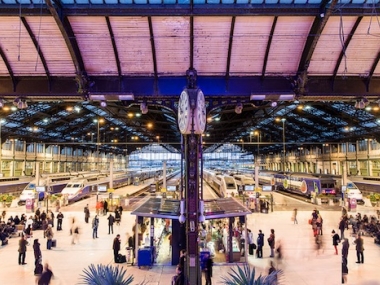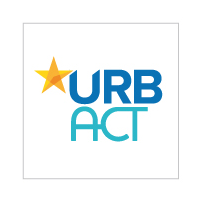Mobility: How Can a City Make the Most of a Railway Hub?
Edited on
22 July 2015Railway hubs can be at the same time a tool and an engine for a sustainable urban and territorial development of the surrounding areas. ENTER.HUB project recommendations tell us how that can be done.

Halfway though the project, ENTER.HUB partners and their Local Support Groups have produced a series of recommendations for cities working to integrate railway hubs in the tissue of middle-sized cities. Their recommendations mix issues of urban planning, mobility and citizen participation for a sound recipe for integrated urban development.
10 on URBAN PLANNING AND MOBILITY
Producing Multi-Polar Networks
. . . R1. Combine fast and slow mobility, and augment fluidity Reggio Emilia: “The Mediopadano Hub will be an interchange and an intermodal node whose core is the Mediopadana station. It is a node because it should be able to easily connect HS line with local railways (interchange) and freeway (intermodal)”.
. . . R2. Reduce distances and time dedicated to mobility Creil Agglomeration: “A reorganisation of the public transport supply to reduce travel time and optimize routes.”
. . . R3. Consider HST railway station as a link between national, metropolitan and local networks Ulm: “One should connect the public and the station with the urban transport system and use the station as hub for all modes of transportation.
. . . R4. Take advantage of international corridors and of existing metropolitan paths Ulm: “The city is part of the high-speed railway line, a global connection through TEN-T, and the axis/corridor "Magistrale" Paris-Stuttgart-Ulm-München-Salzburg-Wien-Budapest”
. . . R5. Think about public space as a possible universal walking area Gdynia: “The hub area will receive additional value by transforming the square on Dworcowa-Starowiejska intersection into pedestrian friendly zone and construction of new shopping centre- extension of trade and culinary offer.” Preston: “Preston has routes into public realm which include parks (Winckley Square, Avenham& Miller) and retail offers (Fishergate Central).” Łódź: “The priority of the New Centre of Łódź program is to create attractive and properly maintained city spaces. New points will appear on the map: the market, the EC1 square, pedestrian lines in main area’s axes both in north-to-south and east-to-west directions, and many others.”
Introducing a Creative Approach
. . . R6. Consider Public Space as a logistically accessible world All partners: “Major issue is to improve the quality of life and the accessibility of the hub and design a mostly accessible public space around it, with green areas, pedestrian areas, linked with nature.”
. . . R7. Develop facilities inside and outside the Hub to serve an Economic strategy Creil Agglomeration: “Our project aims at building a compact centre of the agglomeration around the station, and providing amenities and services (housing, offices, shops, etc.) accessible to a large territory.” Encouraging Changes of Behaviour
. . . R8. Consider Time Management as well as Space Design Porto: “Let’s set up a national card that permits travel across the whole country, or even the Peninsula in Spanish-Portuguese case”.
. . . R9. Set up a bike plan; Facilitate car sharing Creil Agglomeration: “An online platform, which provides information on multimodal routes at the scale of the department, ensures interface between supply and demand of car sharing.” Preston: “The city has developed a cycling route – the Guild Wheel – around the city which facilitates access to the city centre by bike.”
. . . R10. Set up partnerships and coordinate complementarity between all stakeholders Örebro: “Citizens were from the very first beginning involved in the planning process for a new travel centre. Around 1000 people travelling to or living in the region were interviewed before the first sketch was drawn.”
10 on GOVERNANCE AND PARTICIPATION
Governance
. . . R1. Make a comprehensive mapping of stakeholder interest and identify key players – each Hub project will have its own context and specificities in this respect.
. . . R2. Use all means at your disposal to bring essential delivery partners into the core group – convincing of mutual benefit, identifying win-wins, negotiation, political leverage, regulation, legislation...
. . . R3. Public authorities and agencies can take an exemplary lead in developing high performance cooperative working i.e. between region and city, between neighbouring municipalities, between railway and bus companies...
. . . R4. Set realistic targets in terms of development and timing – scale appropriate to catchment and throughput, some development processes need to be recognised as long term and also need to be communicated as such.
. . . R5. Establish an effective leadership structure It can be a plural form of leadership or single agency driven but ultimately informed decisions need to be taken and put into operation. “One has to be sitting in the driver`s seat but plenty of others have to be in the car and say where they would like to go”.
. . . R6. Exploit the opportunity of fixing non-negotiable deadlines Complex projects like Olympic facilities are usually delivered on time because of the strong multi-level commitment, all faces pointing in the same direction - although it must be conceded not always on budget.
Participation
. . . R7. Build a strong communication strategy making full use of existing and new (social) media opportunities.
. . . R8. If participation is genuinely intended to inform, input and co-produce then it should be incorporated at the outset and with a perspective of continuity (not necessarily at all times and on all issues). If participation is only introduced at a later stage or when difficulties arise there is a risk of obstruction, delay or even conflict which is then in contradiction with the principle of governance.
. . . R9. Clearly set out what is possible and what is not. The challenge is to explain what is possible and what the limits of the planning and participation process are.
. . . R10. Develop a system of participative monitoring to ensure that development and service provision continues to respond to citizen needs and expectations – the primary role of a Hub facility is still to serve both travellers and the wider population.
Read more:
ENTER.HUB minisite – URBACT website
Governance and Participation - Project output
Enter.Hub Baseline Study - Project output
 Submitted by URBACT on
Submitted by URBACT on




